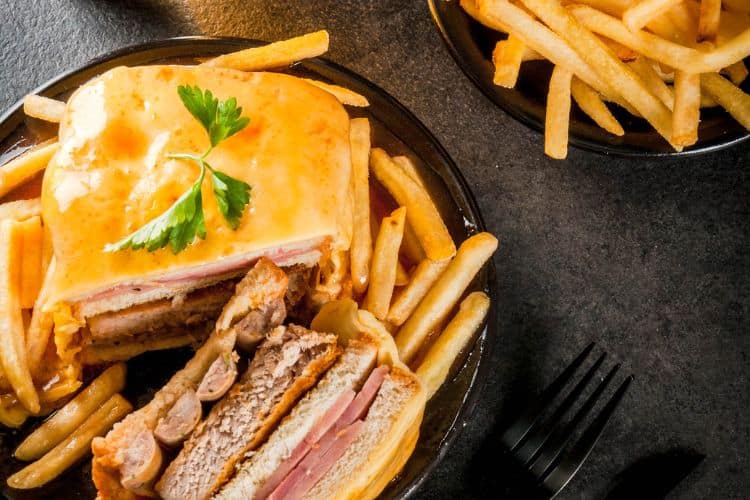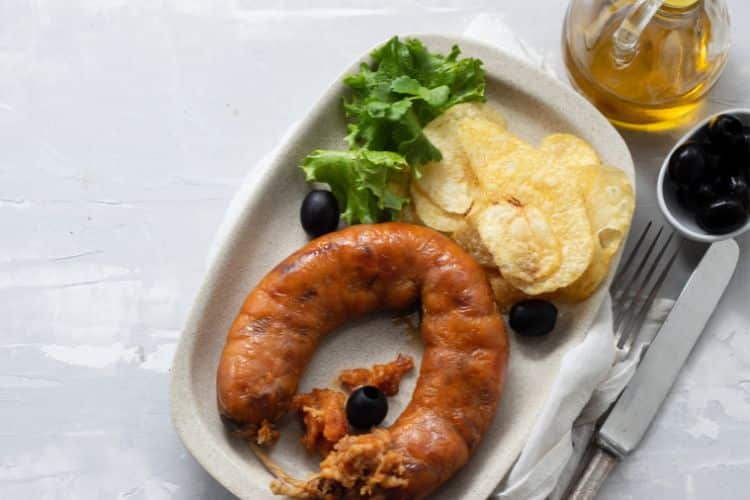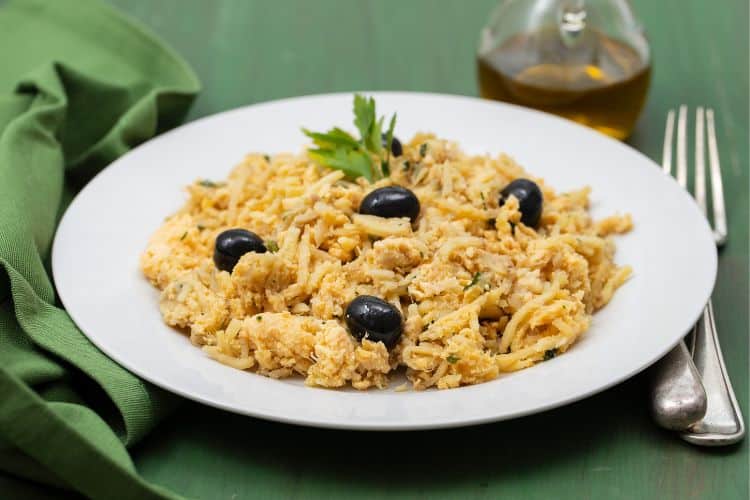29 de November, 2023

Portugal is well known for its rich gastronomy, a reflection of the interactions with various nations and the mixture of influences accumulated over the centuries. From the Moors and Romans to trading partners and inhabitants of former colonies: each people who came into contact with the Lusitanians added some new element to Portuguese food. The result is a very diverse and tasty menu, awarded worldwide. For many, this is a decisive factor in choosing Portugal as a tourist destination!
Realizing your goal of living in Europe or obtaining European citizenship can be simpler than you think. We offer personalized support to make the immigration process more accessible and uncomplicated.
Each recipe in Portugal holds chapters of the country’s history and trying them is like traveling back in time. In Portugal, celebrations always take place around a bountiful table and a meal is much more than just food. Eating is socializing! Among the most common ingredients used to prepare Lusitanian food are olive oil, eggs, seafood, bread, and some vegetables.
Atlantic Lovers* has chosen the best Portuguese dishes, the ones you can’t miss when you visit the country. They are:

We begin our list with a typical dish from Porto. Its origin dates back to the 16th century. At the time, the ships and boats that left for the conquest of Ceuta were being built on the banks of the Douro River. While many people worked hard to build the ships, others prepared provisions for the fleet. Thus, the people offered all the beef available in the city, which after being cleaned and salted, was stored in the ships.
And since only the tripe remained for the local population, they created a recipe that is still one of the most famous of Portuguese gastronomy: the “Tripas à Moda do Porto”. Also because of this story of overcoming and solidarity, the citizens of Porto are still called tripeiros (tripe eaters).
There are other versions about the origin of this dish, but this is undoubtedly the most widespread. The dish is made with white beans, vegetables, and meat. Today, besides “tripe”, chorizo, pork ribs, veal, and beef are also added. The seasoning includes bay leaves, tomatoes, white wine, pepper, and paprika.
Here is the recipe and learn where to try it.

Another typical dish from Porto is Francesinha. We are talking about a sandwich prepared with flatbread and stuffed with meat, ham, sausage, sausage, and topped with a slice of cheese and a spicy tomato sauce. In 2011 it was considered by the American website Aol Travel “one of the 10 best sandwiches in the world”. This is due to the prestigious sauce that accompanies it, served generously on the side. Each restaurant keeps the recipe for its sauce under lock and key, and strives to make the best Francesinha in town.
Here too there are different versions for its origin. Some say that this was a type of sandwich eaten by the soldiers of Napoleon’s army during the Peninsular War. To the preparation, the people from Porto would have added only the sauce. Another version, more widespread, is that the dish would have been created in the 50’s, by Daniel David Silva, a Portuguese who, after living in Belgium and France, developed this recipe inspired by the French croque-monsieur, but with a Portuguese touch. Since it was a good and cheap recipe, it soon spread throughout the city.
But what about the name “Fancesinha”? The name would be a reference to French women, who were more daring and spicy than the Portuguese women of the time.
See here the recipe and learn where to try.

At the end of the 15th century, beginning of the 16th century, the Jews in Portugal were forced to become New-Christians. During the Inquisition, they were constantly persecuted by the population. One of the ways to identify a Jew was to check whether he ate pork or not. This is because the Jewish religion forbids its consumption. Therefore, to deceive the inquisitors, the inhabitants of Mirandela, in the region of Trás os Montes, created a sausage made with bread and chicken, which resembled the traditional pork sausages. And so the alheira sausage was born, an absolutely delicious dish!
This sausage can contain different types of meat such as duck, chicken, veal, rabbit, and bread. Its seasoning usually includes garlic and spices. It is usually served with fried potatoes and fried egg. Very versatile, the alheira sausage can also be used as an ingredient in appetizers, puff pastries, dumplings, and other delicacies.
See here recipes prepared with alheiras and know where to try.

The origin of this dish reflects the Arab presence in Lusitanian lands, especially in the Alentejo region. There are variations in the preparation, but one can say that the most basic açorda consists of pieces of bread dipped in a broth of hot water seasoned with cilantro and garlic.
It was a subsistence food, present among the less favored classes and in food crises. Nowadays it is prepared with seafood broth, shrimp, clams, cockles, or codfish, mixed with bread, egg, seasonings, and lots of olive oil. In other words, a recipe much richer in ingredients.
A drier version of Açorda Alentejana is called “Migas”, another typical delicacy of the region. Both deserve attention in Portuguese gastronomy.
See here the recipe and learn where to try.

It is impossible to think of Portuguese food without remembering the classic cod. The ingredient is a star of Lusitanian gastronomy and used in dozens of recipes, as we have already mentioned in our article about the Symbols of Portugal. It is estimated that Portugal consumes, on average, 20% of the cod caught in the world! The potato is the great partner in most of these preparations. Just remember the famous codfish dumpling, served in every bakery in the country.
Among all the recipes, however, one deserves to be highlighted: Bacalhau a Brás. Launched by Taberna do Sr. Braz, in Lisbon’s Bairro Alto, it is an easy-to-prepare dish, based on shredded cod, fried potatoes, and scrambled egg. Thanks to its great acceptance, it is also widely consumed in Spain, under the name of Revuelto de bacalao a la portuguesa or as Bacalao Dorado.
See here the recipe and learn where to try.

Many will say that the sardine is typical of Spain. In fact, the origin of the name “sardine” is attributed to the region of Sardinia, an island located in the Mediterranean Sea, where this fish used to be abundant. Although it is consumed in other countries, the sardine has become a tradicional national symbol of Portugal for centuries.
In the past, it was consumed only by the less favored classes, and served on bread to “render” and give satiety. Today, although it is still a cheap fish, it is enjoyed by all classes, especially in the summer and during the popular festivals between June and September, when it is grilled on the sidewalks and served in many restaurants.
The most traditional way to prepare this fish is on hot coals, with plenty of salt. During the summer, when they are bigger and fatter, there are several festivals where the sardines are the queen of the party. O Portimão Sardine Festival is one of the most famous.
The sardine is so present in Portuguese culture that it is printed on postcards, fabrics, and souvenirs sold in the country’s souvenir stores. So it doesn’t matter if it is present in other countries: none of them are as connected to this delicacy as Portugal!
See here the recipes and know where to try.

A recipe celebrated in poems and songs from Portugal! Amália, in the classic song “A Casa Portuguesa”, already said: “Basta Pouco, Poucochinho para alegrar uma existência singela! É só Amor, pão e vinho, e um Caldo Verde, verdinho a fumegar na tigela!”
Caldo Verde is the most famous Portuguese soup, originating in the Minho region, created in the 15th century and simple and inexpensive to prepare. It involves cooking potatoes and onion and garlic, which is then whisked and boiled together with thinly sliced kale. At the end, olive oil and slices of chorizo are added. It is especially good on colder days.
See here the recipe and know where to try it.
The list above is our choice. In 2011, the Portuguese held a contest to elect the 7 Gastronomic Wonders and promote the national gastronomic heritage, a testimony of Portuguese cultural identity. The election had popular vote and in a list of 70 options the most voted were:
These are just some of the foods that will conquer you in the country. Did your mouth water? Which of these dishes did you already know? Which ones do you still want to try? Portugal will win you over with its stomach!
Do you want to live in the country? Talk to our consultants!
Atlantic Lovers* is a special edition of Atlantic Bridge that has as its mission to integrate our clients, friends and partners around the best that Portugal has to offer.

Author:
Atlantic Bridge